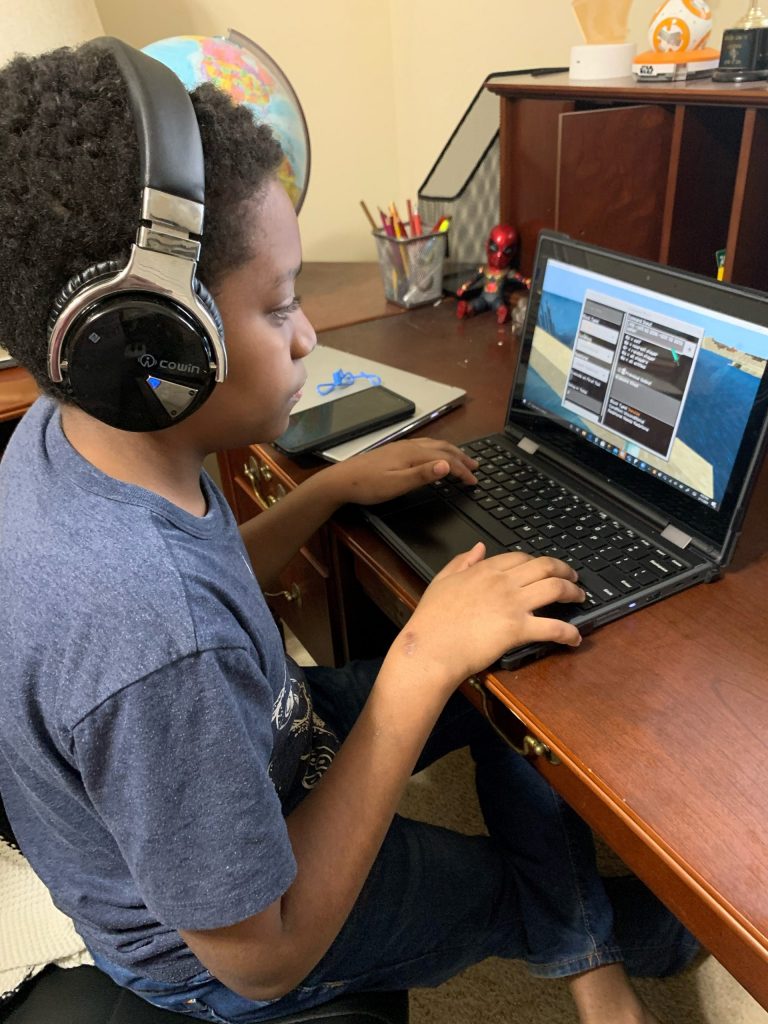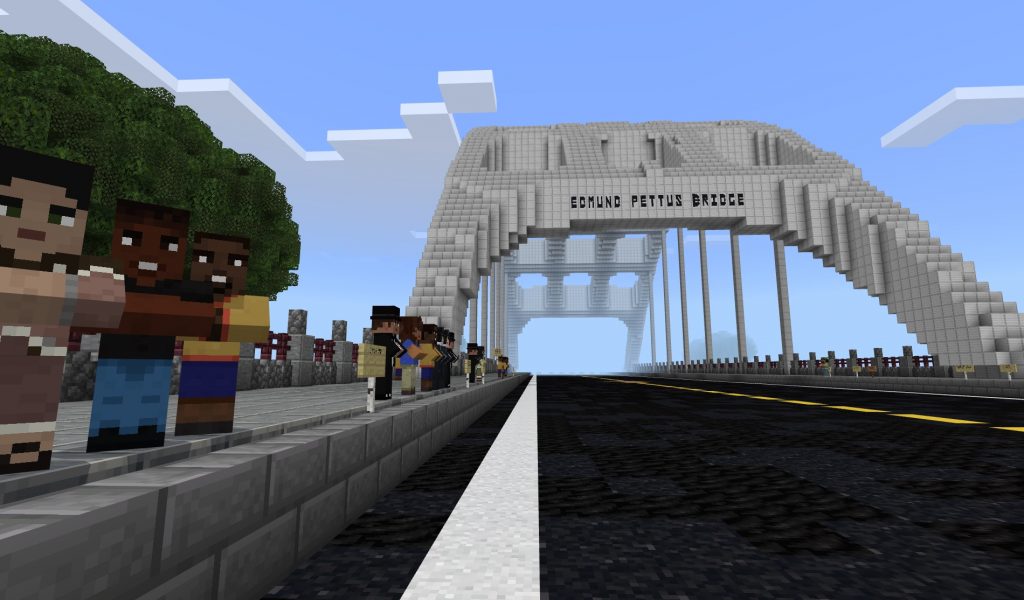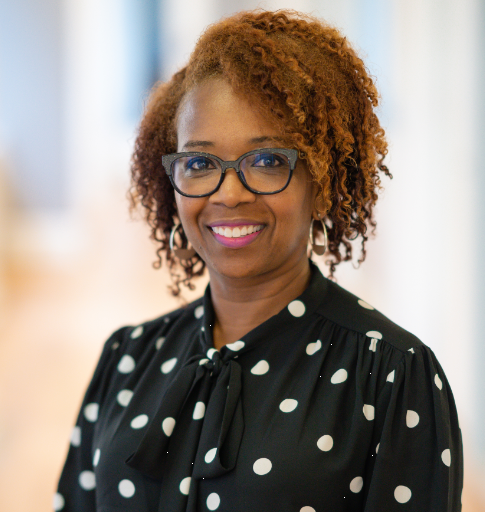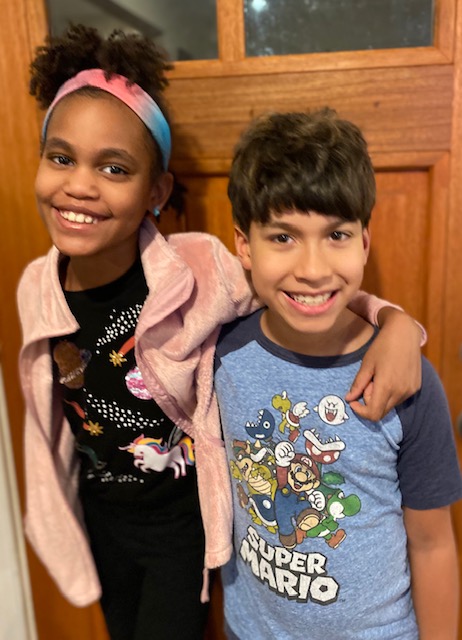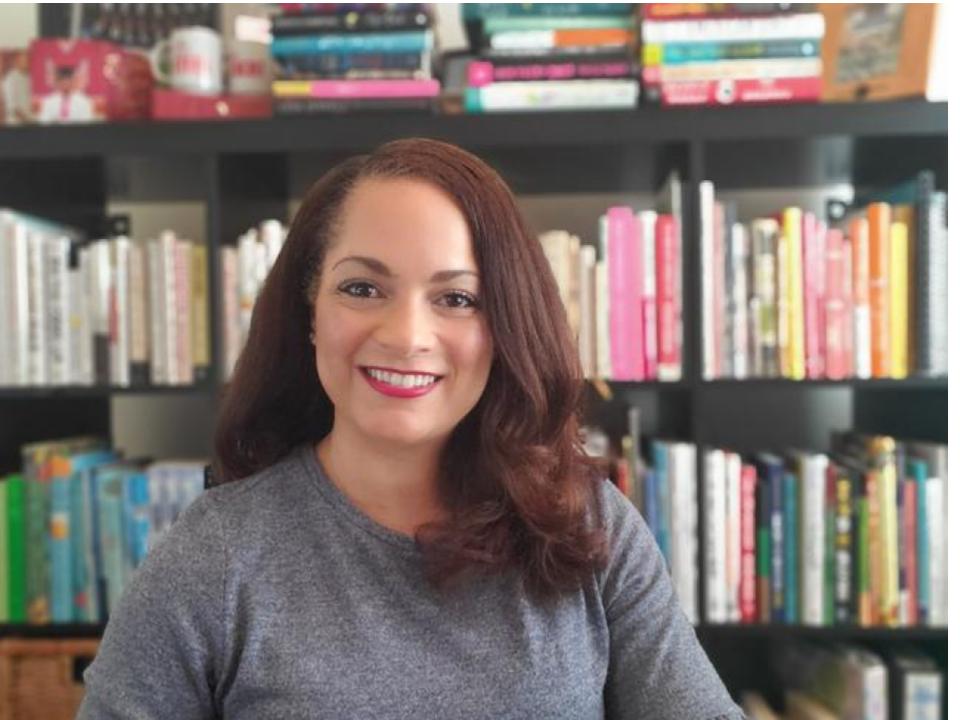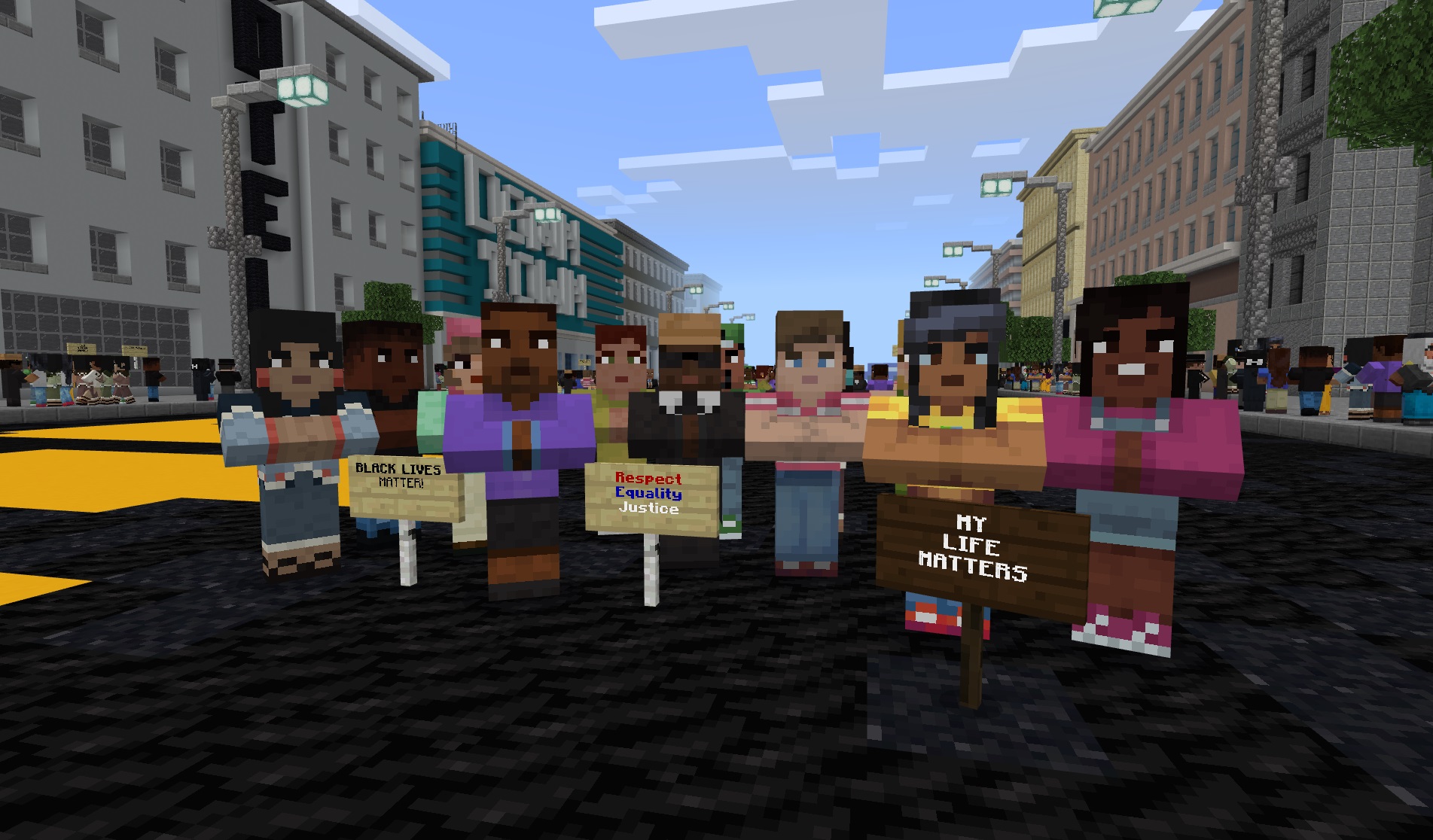
With lessons rooted in social justice movements, Minecraft’s Good Trouble aims to help build a better world
Ralph A. Long IV is only 13, but he’s been playing Minecraft about half his life. He likes how freeing it is, how he can build whatever he wants – houses, bases, tunnels that lead out of mountains. He learns about mining, pick axes and Earth’s resources. He likes playing with his friends in multi-player modes. He applies what he’s learned to real-life subjects such as math and chemistry.
Long has spent most of the pandemic in remote schooling, a situation he says has definitely “not been a cakewalk.” But being home has meant more Minecraft hours. More recently, the Atlanta-based seventh-grader discovered another Minecraft world on his Xbox Series X: “Good Trouble: Lessons in Social Justice.”
One of the things that made the biggest impact on him was seeing representations of the civil rights protests led by Congressman John Lewis, when he and a handful of others faced hundreds of police and state troopers and their dogs.
“You have a sense in that situation of how really scary it was for them, because I can’t imagine going against police officers now,” Long says. “One police officer is scary.”
Seeing the protesters stand up against overwhelming forces really brought the Black Lives Matter protests of the past year home for him.
“It made me feel like they were trying to do something other than the average normal daily lesson,” he says. “It’s surprising just how immersive it was, too.”
The module, released in November, includes many famous activists throughout history and the world – such as Malala Yousafzai, Mahatma Gandhi, Nelson Mandela and suffragist Emmeline Pankhurst – and learning zones that take learners of any age to many places, including Selma, Alabama, India, Pakistan, the U.K. and South Africa.
The latest two Good Trouble lessons are on the Black Lives Matter and U.S. civil rights movements (focused on the march across Edmund Pettus Bridge, the Greensboro Lunch Counter Sit-Ins and Rosa Parks’ protest against public segregation). There will be 10 lessons in all, releasing over the course of spring. They all reinforce how “good trouble” – the kind Lewis was known for causing to secure the right to vote – can build a better world.
In addition to the Good Trouble lessons, the Minecraft Education team released two new lessons for Black History Month that cover Dr. Martin Luther King Jr. and include self-identifying exercises that lead to a “Museum of Me.”
Good Trouble is gaining great traction, with more than 2.1 million downloads around the world.
“I would say that’s the best indicator that we have of the relevance of this,” says Deidre Quarnstrom, who leads the Minecraft Atlas Team that includes Minecraft: Education Edition and Minecraft China. She also leads diversity and inclusion efforts across the Minecraft franchise, which has donated more than $2 million to organizations supporting Black Lives Matter. “Our goal is really to bring Minecraft into mainstream education. We saw the potential to teach coding, but also to explore topics like empathy, social justice, social emotional learning and digital citizenship.”

Visit Black Lives Matter Plaza to learn about the key motivations for the movement, its cultural context, its outcomes on society and how de-centralized activism can be a powerful force for change.
Hundreds of lessons for Minecraft: Education Edition are created by educators, or by game designers in partnership with educators or curriculum designers. While the Good Trouble lessons were at first only accessible through the Education Edition, the map is now also free in Minecraft’s Bedrock version marketplace.
Minecraft education modules have augmented chemistry, computer science and coding curriculums. At a high school close to Microsoft’s Redmond, Washington, campus, a class integrated a Minecraft coding lesson into a humanities class in which students were studying Shakespeare. They programmed the agent in Minecraft to write code to build their version of the Globe Theatre, the 16th century venue where performers originally enacted The Bard’s plays.
“There’s a lot of focus on social emotional learning in schools, even before the pandemic. We’ve seen that amplified during the pandemic, as students have been at home, isolated from friends in many cases, spending a lot of screen time on online school,” Quarnstrom says. “Educators and school leaders are looking for ways to fill that social connection and creativity while also recognizing the Black Lives Matter movement and just how that has come so much more into the forefront in 2020.”
Felisa Ford, a digital learning specialist and Minecraft certified teacher and trainer for Atlanta Public Schools, helped develop Good Trouble. Ford’s inclusion of the late congressman was personal; he was her representative and someone she knew. Every year on the anniversary of Bloody Sunday, she would take students on a field trip to Selma, where they’d see Rep. Lewis and draw inspiration from him.
“The Minecraft team reached out to me to see if we could do something with Minecraft around the social justice and the Black Lives Matter movement,” says Ford, who has a background of 27 years as an educator, teaching high school social studies and serving as a high school principal before transitioning to a social studies coordinator and digital learning specialist in instructional technology. “We wanted to show that across the world and across time, there have always been people who have gotten into good trouble standing up for the rights of others.”
Within every lesson learners are asked to reflect on how they’ve been a catalyst for good trouble within their schools or communities, or if there’s been a time when they stood up for a friend.
Ford says that for students seeing protests in the Minecraft world, there is a bridge that connects the real world and what they see on the news to what they are used to experiencing on a computer screen, making for a more powerful impact than when they only see it on the news – especially when they see people who look like them.
“With so much going on in the world today, this has had a huge impact on students of color,” she says.
Two children who are lifelong friends tried out the lessons, thanks to their moms, Elizabeth Woods and Merron Negusse. Both are teachers who work closely with Krynica Drake, an educational technology specialist for Atlanta Public Schools, who is also a Microsoft Innovative Educator Expert and Microsoft Fellow.
“She really taught both Merron and me about Minecraft, so that we could share it with not only our students but also our kids,” says Woods. “She totally deserves a lot of the credit for putting this in our kids’ hands and so many others.”
Skylar Maxey, 9, and Evan Woods, 8, have known each other pretty much their whole lives, so it was only natural that they would do a video interview together, too.
Both go to Burgess-Peterson Academy in Atlanta and are a grade apart – fourth and third. Maxey got a head start on Minecraft, discovering it through her cousins two years ago, while Woods started playing about nine months ago.
“I like how it was realistic; you could craft a boat, swim in the water and fish,” Maxey says. “You can make actual what you dream.” She also liked how Minecraft helps her to be creative and solve problems.
Woods’ favorite parts are the eggs that hatch dolphins, parrots and fish. “I just build whatever my mind came up with. I could build a house or an entire fort, anything I could imagine.”
They shared their experience with the Good Trouble lessons.
“It feels so realistic, it’s telling you true facts about all those people,” says Woods, who appreciated learning about Black people in a historical context, in addition to what he’s already picking up in class through Black History Month lessons. His favorite subject in school is social studies. “I learned about John Lewis and what he did. There’s activities, videos and guides. It’s an open world place where you can just explore. It’s an adventure going to every person.”
Maxey, whose favorite subject is reading, liked doing all those things too, and learning about the women’s suffragette movement in the U.K.
“I was more into Malala. I like that she stands up for women’s rights and for people to go to school, not just boys, but boys and girls,” says Maxey, who volunteers to show off the character on her screen and how it talks to her when she toggles a button.
“If you look outside a window in Good Trouble, you can see people outside holding Black Lives Matter signs,” she adds.
Both really liked how the lessons reflected the world they live in – and the people around them daily.
Natasha Rachell, a digital learning specialist for science for Atlanta Public Schools and former high school science teacher, worked with Ford and Ken Shelton to create the Good Trouble lessons.
“Felisa and I both had the pleasure of meeting John Lewis numerous times. He was an amazing human being with such a gentle heart. He really cared about people and children and reading, so if you go into the Minecraft world you’ll notice books that line the street where he is,” says Rachell, who has a doctorate in organizational leadership with an emphasis in effective schools. “I think it came out at the perfect time, but it does make me sad that he’s not here to see what we created.”
Her sons introduced her to Minecraft. They’d spend hours building and creating. Back then, she only thought of it as a video game. She’d tell her boys to turn it off. Then the Education Edition came out and the training opened her eyes.
“You see the value in it. Your whole perception totally shifts,” she says. “Then I was OK, play it all you want!”
Her younger son, she says, “will take things apart and put them back together. He has told me he wants to pursue engineering as a career. And I really do believe being exposed to Minecraft had something to do with that.”
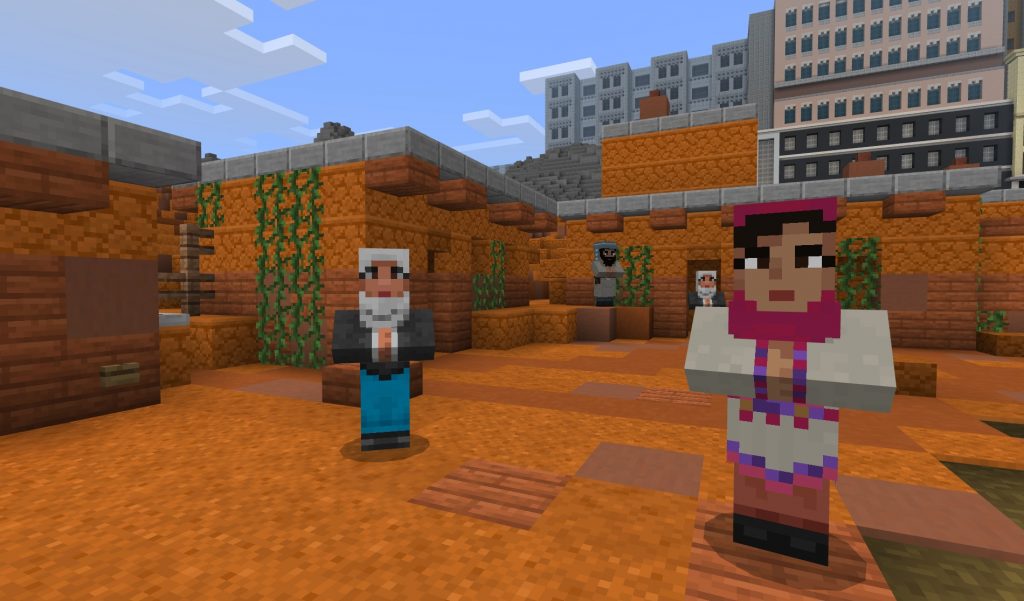
Visit Malala Yousafzai in Pakistan to learn about her courageous stand against the Taliban’s ban on girls’ education.
Her experience in understanding the benefits of Minecraft helped her convey its value to other teachers.
“All they have to do is take that lesson plan and execute it. Minecraft is a tool for the students to be able to deliver the content, and so I always talk to teachers about not having to be the experts in Minecraft,” Rachell says. “I compare Minecraft to being the equivalent of PowerPoint or a Word document or something like that. It’s a tool that your students are going to use to showcase their learning, so you don’t have to be the expert in Minecraft.”
Students also learn to work together within Minecraft, building a community that gives them collaboration skills useful in their future life. And right now, with so many students still learning at home, it’s an opportunity to check out the Good Trouble lessons.
“They are creating in their learning, they’re being innovative and going through the learning process or the design process so they‘re having fun and playing,” Rachell says. “I think in a remote setting it’s almost a seamless process. This is like the perfect time to have students jump into Minecraft.”
Head over to Minecraft: Education Edition if you want to learn more.
Lead image: Screenshot from Minecraft Good Trouble lessons showing activists from the Black Lives Matter movement as they stand together and seek justice for the Black community.

